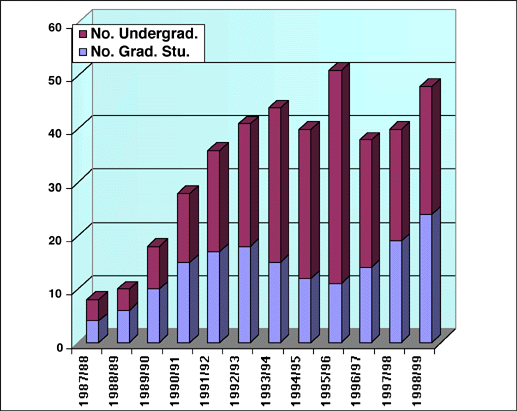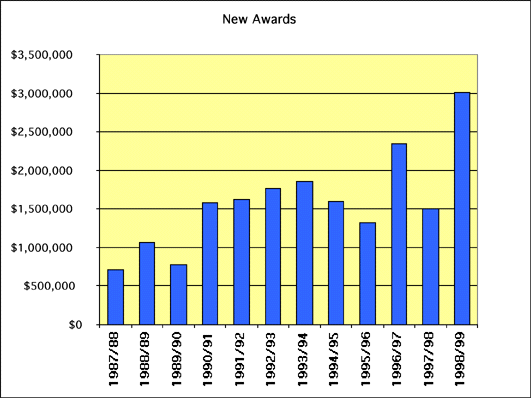Director's Statement
In November we had a thorough five-year review of the Institute for Crustal Studies. The reviewing committee (Prof. Eli Silver, UC Santa Cruz; Dr. Leonardo Seeber, Lamont-Doherty Earth Observatory; Dr. Richard Ragaini, Lawrence Livermore National Laboratory; and Prof. Joann Stock, California Institute of Technology) pointed out the strengths and weaknesses of ICS as seen both from internally and externally. Following their report and reviews by the UCSB Academic Senate Committees (Committee on Educational Policy and Planning, Committee on Research, Graduate Council) the Office of Research extended the charter for the Institute for Crustal Studies for another five years. While this review took considerable effort by all of ICS staff, researchers and advisory committee members, it was a very useful exercise for us to look back on our accomplishments and look forward to the challenges of the next five years.
One trademark of ICS has been our continued growth. This past year ICS researchers garnered 48 awards totaling three million dollars. (This has the caveat that it includes two of the Southern California Earthquake (SCEC) awards within one fiscal period.) Even without the second SCEC award arriving the award amount–2.4 million dollars–still sets a record. While the numerical dollar amount is one type of measure, it is more a reflection of the energy and quality of research that ICS researchers continue to pursue. In every category–number of proposals submitted (75), number of projects administered (76), number of principal investigators (44), the number of graduates (24) and undergraduates (24)–there has been a marked increase during the past year.
Besides the increase in research activities there has been more recognition of the researchers at ICS. Special recognition was given to Dr. Lorne Everett in his receiving the Russian Academy of Sciences gold medal, the Kapista award for his contributions to surficial hydrology and the measurement and remediation of contaminants in the ground above the water table. While nothing is quite the equivalent of the Kapista award, ICS researchers have established an international reputation. For example, Dr. Alexei Tumarkin was invited to the Disaster Prevention Research Institute of Kyoto University. Prof. Ralph Archuleta was invited by the Buildings Research Institute in Tsukuba, Japan to give one week of lectures in Tsukuba as well as in Tokyo. Archuleta was also invited to give one of the four state-of-the-art papers at the Second International Symposium by IASPEI (International Association of Seismology and Physics of the Earth’s Interior) Effects of Surface Geology on Seismic Motion Conference in Yokohama. Dr. Kim Olsen was invited to the Ecole Normal in Paris to continue his collaboration with Professor Raul Madariaga. Similarly, Prof. Toshiro Tanimoto was awarded a research fellowship to study at the Earthquake Research Institute at the University of Tokyo.
Perhaps one of the more important aspects of ICS is its visitor program in which we try to attract visitors to stimulate new areas of research that we might in fact find intriguing and exciting to continue along with our own lines of research. Among those visitors this past year were Dr. Jim Dieterich of the US Geological Survey, who spent over two and a half months working on problems related to friction and fracture. Dr. Antonio Azor from the University of Granada came to spend six months working with Prof. Edward Keller on different aspects of geomorphology. Dr. Taro Okamoto has been here from the University of Tokyo to collaborate with Prof. Tanimoto on problems of wave propagation and structure of the earth. All of these visitors have made a significant contribution both to the intellectual atmosphere as well as the personal atmosphere of ICS.
Researchers at the ICS have had a 10-year program in borehole seismology–recording of seismic waves at various depths extending to 500 m. As testimony to their effort, the Institute for Crustal Studies received its largest donation from Kajima Corporation. They donated to ICS researchers the Hollister Earthquake Observatory, valued at $1.25 million dollars. HEO is an array of borehole accelerometers that had been installed and operated by Kajima since 1991. The award letter cited the long-standing efforts of ICS researchers as the primary reason for the donation.
Not everything has gone as smoothly as we had hoped. The Department of Geological Sciences and ICS conducted a search for a professor who would also be the new director of ICS. This search was almost successful. An outstanding candidate in tectonic geodesy was identified, but his home institution countered with an offer that persuaded the candidate to stay. This search has been reactivated in 1999 with the expectation of a new director for the new millennium.
In certain areas we have always been very careful and very outstanding, and that is in the area of undergraduate and graduate education. David Oglesby completed his Ph.D. dissertation on earthquake dynamics on dipping faults. He has since moved to San Diego State University on a post-doctoral fellowship to work with Professor Steven Day. Three of our undergraduates worked on research projects during the summer as SCEC interns: Javier Santillan, Lowell Kessel and Leland Green. Several of our researchers have been active in the Department of Geological Sciences. Dr. Pete Rodgers taught Introduction to Geophysics; Dr. Craig Nicholson taught a course in Reflection Seismology, Dr. Nicholson was named Adjunct Professor in the Department.
In retrospect ICS has continued on the upward trajectory that started 11 years ago. ICS continues to support more investigators and students in their pursuit of interesting research ideas. From the critique of the previous five years we know that while we have some accomplishments, there are many roads of research that can be traveled. It is the purpose of ICS to foster as many hikes down these roads as possible.

Figure 1.

Figure 2.

Figure 3.

Figure 4.
Home Page || E-mail